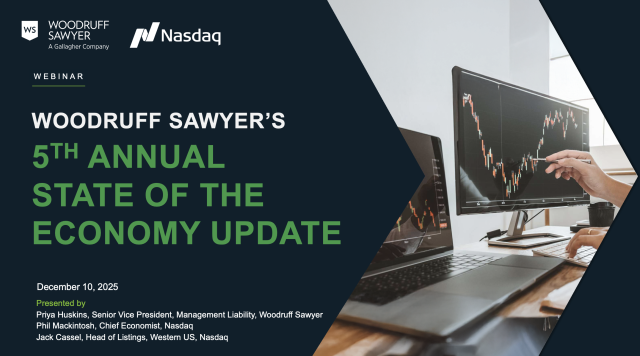Blog
Lesser-Known Securities Law Theories and D&O Risk
Most federal private securities litigation is brought under Section 10(b) of the Exchange Act and Section 11 of the Securities Act. These two provisions are responsible for most of the big-ticket securities class actions that can lead to large losses for companies without adequate D&O insurance in place. But the federal securities laws also create other private causes of action that shareholder plaintiffs use from time-to-time to bring creative claims against companies. In this week’s edition of the D&O Notebook, my colleague and former securities litigator, Walker Newell, looks at lesser-known shareholder claims and what they mean for D&O risk. —Priya
In private securities litigation, plaintiffs can choose from a variety of statutory claims when suing companies, officers, and directors. Most modern shareholder class actions include some combination of:
- Section 10(b) of the Securities Exchange Act of 1934 (“Exchange Act”). This is the primary anti-fraud provision of the federal securities laws, which imposes liability on defendants who cause shareholder losses by making materially misleading statements or omissions with scienter (i.e., bad intent). There is a presumption of “reliance” in Section 10(b) cases involving material stock price declines.
- Section 11 of the Securities Act of 1933 (“Securities Act”). Like Section 10(b), this provision imposes liability for materially misleading statements, but only statements made in registration statements (i.e., those filed for initial public or secondary offerings). Unlike Section 10(b), Section 11 has a strict liability standard and does not require intent.
- Section 15 of the Securities Act and Section 20(a) of the Exchange Act. Under these provisions, “control persons”—i.e., individuals who did not directly make false statements but allegedly “controlled” other individuals or entities who did make false statements—can be held liable if there is a “primary violation” (e.g., of Section 10(b) or Section 11).

These are not, however, the only ways for shareholders to sue companies, officers, and directors in federal securities cases. Plaintiffs’ lawyers know the federal securities laws as well as anyone, and they are always looking for ways to leverage these 90-year-old statutes to their advantage. Let’s look at one of the lesser-known theories that pop up from time-to-time in securities litigation and how these types of claims may impact D&O risk.
Section 18(a) of the Exchange Act
Just a few pages down from Section 10(b) in the Exchange Act, Section 18(a) has received much less attention over the decades. But why? On its face, Section 18(a) looks a lot like Section 10(b), imposing liability for false or misleading material statements to investors. It seems like Section 18(a) could have been a contender. Well, Section 18 has some key differences from Section 10(b), making it a non-starter for plaintiffs in many cases.
Most significantly, to win a Section 18(a) claim, shareholders need to demonstrate actual reliance. This means that shareholders need to allege—and then presumably prove at trial that they read and relied on the relevant false statements when buying or selling stock.
This requirement differs from the reliance standard in Section 10(b) cases, where plaintiffs can generally allege that because the company’s stock traded in an efficient marketplace, shareholders who bought or sold stock during the relevant period would have done so in reliance on publicly available false statements.
This distinction is a big deal. In Section 10(b) class actions, plaintiffs can aggregate thousands of individual shareholders to arrive at big damages numbers. To do so in a Section 18(a) case, plaintiffs would need to prove that every shareholder actually read and relied on the relevant statements. That’s just not feasible.
Also, unlike Section 10(b) and Section 11, Section 18(a) only applies to false statements in filings under the Exchange Act (i.e. Forms 10-K, 10-Q, and/or 8-K, among others). Registration statements—which are filed under the Securities Act—do not qualify, nor do statements not made in SEC filings.
Section 18(a) does have one attractive feature for plaintiffs. Like Section 11, it does not have a scienter requirement (which is one of the biggest pleading hurdles for plaintiffs in Section 10(b) cases). Instead, defendants bear the burden of showing that they acted in good faith and did not know the statements were false.
Given these limitations, how much risk do Section 18(a) claims pose to public companies, officers, and directors? Because of the actual reliance requirement, Section 18(a) is not an attractive claim to include in shareholder class actions, which create the biggest financial overhang for corporate balance sheets and drive the lion’s share of public company D&O losses for insurance carriers.
When Section 18(a) cases come up, it is often because an institutional investor, e.g., a public pension fund or a hedge fund, has suffered significant losses in connection with large trades in a public company’s stock. For funds that actually rely on a company’s materially false statements to place big trades and then suffer significant losses when the company’s stock price declines after the market learns the truth, Section 18(a) may provide a path to recovery. In the right case with enough bad facts, this could presumably lead to a big settlement—even if plaintiffs can’t prove scienter.
Even in such cases, however, proving actual reliance could be tricky, and Section 18 settlements are exceedingly rare in our experience.
D&O Risk Implications from Lesser-Known Securities Law Theories
Section 18(a) is one of a handful of lesser-known securities law theories trotted out by plaintiffs from time-to-time. Other examples include Section 12(a)(2) of the Securities Act (strict liability for false statements in a prospectus or oral communication), Section 9 of the Exchange Act (market manipulation), and Section 20A of the Exchange Act (private cause of action for insider trading).
One of the primary purposes of public company D&O insurance is to help companies, directors, and officers bear the burden of securities litigation brought by shareholders. Assuming policy requirements have been met, D&O insurance frequently responds to cover securities litigation defense costs and settlements—after the self-insured retention (akin to a deductible) has been paid by the company. A “securities claim” is typically defined broadly under public company D&O forms to include securities litigation of any form.
To put a finer point on it: Regardless of whether you are facing a standard Section 10(b) case or a more esoteric theory, a well-negotiated and appropriately resourced D&O insurance program can help your company transfer the risk of expensive defense costs and, if it comes to it, a large settlement.
Author
Table of Contents











